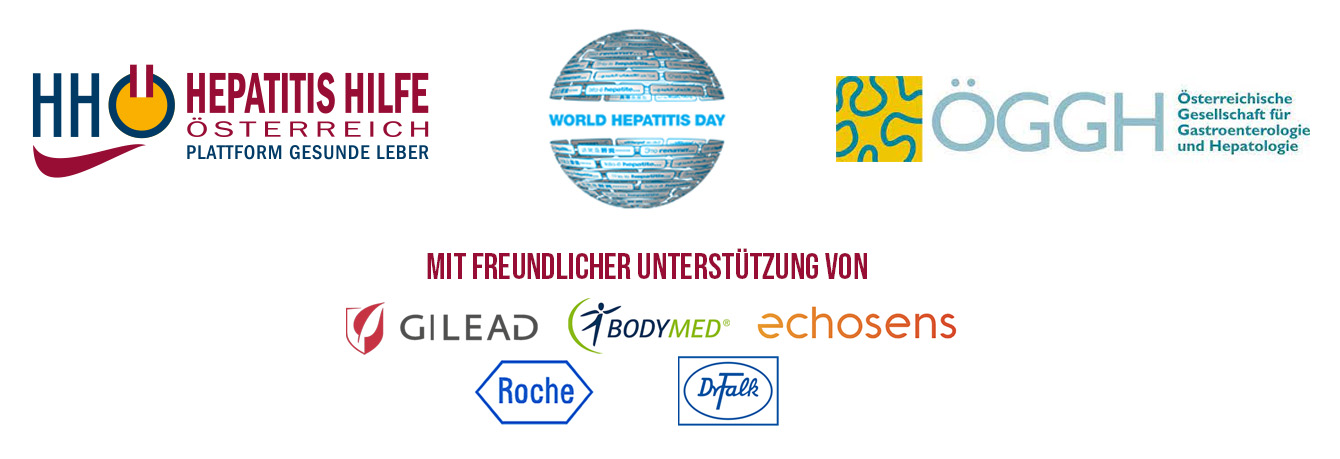World Hepatitis Day 2022
Read the German version of this article.
World Hepatitis Day 2022 – HHA calls for a test offensive for more clarity.
The prerequisites for this are already in place!
July 28th is World Hepatitis Day again, with which the World Hepatitis Alliance (WHA) has been drawing attention to the dangers of viral liver diseases and many other liver diseases every year since 2011. The goal is to eliminate hepatitis B and C by 2030 and to finally raise awareness of liver diseases in Austria. In Austria, this goal is being promoted by the Hepatitis Aid Austria – Platform Healthy Liver Platform (HHA) headed by Angelika Widhalm. As part of the Covid-19 pandemic response, test structures have been established in recent years, which should also be used for the hepatitis rapid tests in order to „finally shed light on the enormous number of unreported cases,“ says Widhalm.
 |
World Hepatitis Day on July 28th has been held worldwide since 2011 to raise awareness of all viral hepatitis (inflammation of the liver caused by virus) and to eliminate these serious liver diseases by 2030. „In order to be able to achieve this goal, new test strategies must be developed,“ emphasizes Angelika Widhalm, Chair of Hepatitis Aid Austria – Platform Healthy Liver (HHA). She is therefore calling on the national government to speed up the fight against viral hepatitis – above all through educational campaigns, screening programs, vaccination and easy and low-threshold access to respective therapies. In addition, Widhalm would like to motivate everyone to get tested. A diseased liver often goes undetected. Chronic hepatitis B and C in particular can gradually damage the liver without the affected person noticing anything. “Every 30 seconds someone dies from viral hepatitis! Let yourself be tested”, Widhalm therefore appeals to Mr and Mrs Austrian „You could save your liver and therefore your life!“
The good news: There are effective vaccinations against hepatitis A and B that protect against infection. Unfortunately, the vaccination rate in Austria is currently only around 60%. „Due to the newborn vaccinations since 1999, we expect further increase in the vaccination coverage in the next few years,“ says Widhalm confidently.
Since 2015, hepatitis C has been curable with a therapy with few side effects, which also has a significantly higher success rate compared to previous therapies.. „In the past, however, the therapies were notorious for their severe side effects, which is why many people simply did not dare to use these therapies,“ Widhalm looks back. „With the so-called DAA’s (direct acting agents), these times are over: comparatively free of side effects and with a reliable healing rate, our recommendation to everyone: do not wait any longer, hepatitis can’t wait.“
There have also been great successes in the treatment of the more recent hepatitis D (delta). This viral liver disease only occurs in connection with hepatitis B and „increases the risk of severe courses fourfold compared to a pure HBV infection,“ emphasizes Primarius, Prof. Priv.Doz. dr Arnulf Ferlitsch, specialist in internal medicine, additional specialist in gastroenterology, hepatology, specialist in internal intensive care medicine, head of the department of internal medicine, gastroenterology and nephrology in the KH der Barmherzige Brüder in Vienna, board member of Austrian Gastroenterological Society (ÖGGH) and Advisory Board of the HHA. But there is also a new, highly effective drug for hepatitis B.
Use Covid-19 test structures and “shed light on the unreported figure”
“In Austria, one must still assume that most of the people who are identified with viral hepatitis do not know anything about their illness,” Widhalm points out one of the main problems associated with this serious illness. “The number of unreported cases is enormous. As a result, most of them only find out about their disease very late, namely through severe liver damage and other serious sequelae caused by these infections. Unfortunately, it is often much too late!” Margit Winterleitner, Head Physician BMJ, is convinced. „Because after 2 years of the Covid 19 pandemic, there is a PCR test structure in Austria that enables continuous and sufficient diagnostics. In addition, we are now slowly getting back to the risk groups.”
Also Dr Gottfried Hirnschall, former Director HIV Department and Global Hepatitis Program of the WHO and Advisory Board of the HHA, emphasizes that hepatitis is still one of the most common and serious diseases worldwide. He speaks of around 3 million new infections every year worldwide and around 1.1 million people who die every year as a result of viral hepatitis. Therefore, he also calls on the health services worldwide and in Austria to bring the test and therapy offers as close as possible to the population.
New widespread disease: Fatty Liver
„A non-infectious liver disease that claims many lives worldwide, but especially in Europe, America and Australia, is still underestimated by many doctors and health politicians: fatty liver – the new widespread disease no. 1,“ explains the HHA chairwoman. It is most often caused by an excessive intake of processed sugars such as corn syrup combined with insufficient exercise, an unbalanced diet (too many carbohydrates, not enough protein) and alcohol. „In Austria, every third man and every fourth woman is already affected,“ says Dr. Ferlitsch concrete figures on this. „Fatty liver is now the most common reason for a liver transplant!“ He therefore calls for appropriate preventive measures and campaigns to inform the population about this disease.
In this context, the HHA demands that all necessary examinations are carried out in the event of elevated liver values and that these are also reimbursed by the health insurance companies. „Unfortunately, that’s not the case at the moment,“ Widhalm refers to a rigorous grievance in this country. „Basically, the elastography examination (FibroScan) should be included in the measures of a conventional preventive examination!“ Preventive therapies must finally be reimbursed by the health insurance companies. For example, the so-called rare liver diseases (PBC; PSC; AIH, Wilson’s disease …) could be recognized in good time so that those affected could be treated quickly.
But there is also good news with regard to fatty liver: „The first studies for a new drug are underway in Austria,“ emphasizes Dr. Ferlitsch, who also calls for awareness of the dangers of fatty liver and fatty liver hepatitis to be created within the population.
Liver cancer is increasing at an alarming rate – new therapies: Primar Dr. Ferlitsch expressly emphasizes that liver cancer has increased exponentially in Austria in recent years and has the third highest cancer death rate. The good news: „There is a good new therapy option with already good results in order to be able to fight this cancer even more successfully,“ says the HHA chairwoman.
The biggest risk factors at a glance
- overweight
- Lack of exercise
- wrong diet
- alcohol
- as well as genetic risk factors
WHO Key-Facts about viral hepatitis
An estimated 15 million Europeans are chronically infected, including 5.5 million living in the EU; 27,000-29,000 new HCV cases are diagnosed in the EU/EEA each year. Evidence shows that in some European countries the annual death toll from HCV has quadrupled over the past 20 years.
Demands of the HHA
- Regular screening for liver disease.
- Offer of free rapid viral hepatitis tests for the population as part of the corona test stations.
- Every hepatitis B patient must be tested once for hepatitis D (delta) in order to initiate the new therapy in good time.
- The creation of a future-oriented hepatitis action plan, which the WHO has been calling for for years, also in Austria.
- Reimbursement of all necessary examinations of the liver (elastography).
- Reimbursement of all proven medical products and nutritional therapies for fatty liver.
About the Hepatitis Aid Austria – Healthy Liver Platform
The Hepatitis Aid Austria – Healthy Liver Platform (HHA) was founded in 2000 by dedicated patients together with doctors and partners from health policy. Since then, the non-profit association has acted as an interface between patients and physicians, authorities, ministries, the Chamber of Labor and Commerce, social security institutions, health insurance companies and regional authorities here in Austria. A scientific advisory board, consisting of well-known medical specialists and scientists, ensures that the HHA’s medical information is reliable, up-to-date and serious. In the future, Hepatitis Aid Austria will work even more closely than before with all the responsible authorities, ministries and relevant institutions in the country, as well as the media.
